
The Japanese spider crab is a species of marine crab that lives in the waters around Japan. It has the largest leg span of any arthropod. They go through three main larval stages along with a prezoeal stage in order to grow to their great size. The genus Macrocheira contains multiple species. Two fossil species of this genus have been found, Macrocheira ginzanensis and Macrocheira yabei, both from the Miocene of Japan. The diverse taxonomic history is an important part of what these creatures are and how they evolved to be what they are today. These creatures are not isolated however, as they are the subject of fishery and are considered a delicacy. Conservation efforts are being put forth to protect these creatures and their population from the dangers of overfishing.
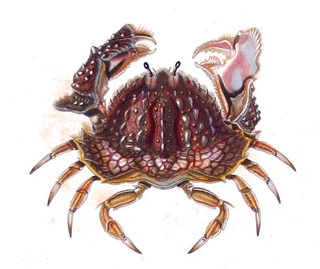
Calappa hepatica, the reef box crab, is a common benthic species of box crab of tropical and subtropical parts of the Indian and Pacific Oceans and the Red Sea.

Notomithrax ursus, known as the hairy seaweed crab, is a spider crab of the family Majidae.

Dromia dormia, the sleepy sponge crab or common sponge crab, is the largest species of sponge crab. It grows to a carapace width of 20 cm (8 in) and lives in shallow waters across the Indo-Pacific region.

Acanthonyx dentatus, the toothed decorator crab, is a species of crab in the family Inachidae.

Nemanthus annamensis, commonly known as the gorgonian wrapper, is a species of sea anemone found in central Indo-Pacific waters.

Xantho hydrophilus, the furrowed crab or Montagu's crab, is a species of crab from the family Xanthidae. It is yellowish-brown and grows to a carapace width of 70 mm (2.8 in). It is a nocturnal Omnivore that lives in shallow marine waters from western Scotland to the Cape Verde Islands.

Lybia tessellata is a species of small crab in the family Xanthidae. It is found in shallow parts of the tropical Indo-Pacific Ocean. Like other members of the genus Lybia, it is commonly known as the pom-pom crab or boxer crab because of its habit of carrying a sea anemone around in each of its claws, these resembling pom-poms or boxing gloves.

Libinia dubia, the longnose spider crab, is a species of crab in the family Epialtidae. It is found in shallow waters on the eastern coast of North America.

Macropodia rostrata, common names, the common spider crab, long-legged spider crab, long-legged crab, is a species of marine crab in the family Inachidae. The Macropodia Rostrata visually mimics many other types of small crabs with the exception of its long legs. By attaching algae to their thin legs, they can be confused with the stem of seaweed. This is both a defense mechanism and a predatory advantage, as unsuspecting fish will hide in seaweed beds from nearby predators. This behavior can be absent among larger crabs, and those that live at great depths like giant Japanese spider crabs.
Portunus sayi, the sargassum swimming crab, is a species of pelagic crab in the family Portunidae. It is found in the western Atlantic Ocean and the Caribbean Sea where it makes its home among floating mats of Sargassum seaweed. It was named in honour of the American naturalist Thomas Say.
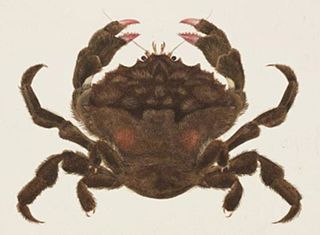
Lauridromia is a genus of crabs in the family Dromiidae. It contains only two species. At one time a third species, Lauridromia indica, was included in the genus but that has now been transferred to the genus Dromidiopsis as Dromidiopsis indica.
Lauridromia intermedia is a species of crab in the family Dromiidae and is native to the western Indo-Pacific. It often carries a piece of sponge on its back by way of camouflage, and one individual was found carrying a sea anemone in a similar manner.
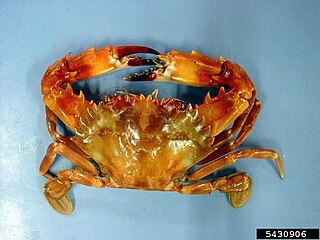
Charybdis hellerii, the Indo-Pacific swimming crab or spiny hands is a species of crab from the swimming crab family, the Portunidae. Its native range covers the Indian and Pacific Oceans but it has been introduced to the western Atlantic and has invaded the Mediterranean. It is a commercially exploited species in south-east Asia.

Eucrate crenata, the blunt-spined euryplacid crab, is a species of Indo-Pacific crab from the family Euryplacidae. It has invaded the Mediterranean Sea from the Red Sea by Lessepsian migration through the Suez Canal.

Actea savignii is a species of Indo-Pacific crab from the family Xanthidae which is one of the spiny-legged rock crabs. It has colonised the Levantine Sea by Lessepsian migration through the Suez Canal from the Red Sea since the mid 2000s.

Ashtoret lunaris, the yellow moon crab, spotted moon crab or box crab, is an Indo-Pacific species of carnivorous crab which is a member of the family Matutidae. It has been recorded in the eastern Mediterranean since 2010, probably reaching that sea through the Suez Canal from the Red Sea by Lessepsian migration.
Notopus dorsipes is a species of frog crab from the family Raninidae which has an Indo-Pacific distribution and which has recently spread into the eastern Mediterranean. It is the only extant species in the genus Notopus.
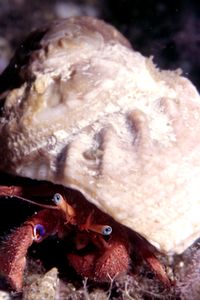
Paguristes eremita, the eye spot hermit crab, is a species of hermit crab in the family Diogenidae. It is found in the Mediterranean Sea.
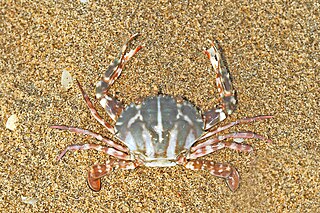
Charybdis feriata, the crucifix crab, is a species of swimming crab in the family Portunidae. It is found in the tropical and subtropical Indo-Pacific region.


















